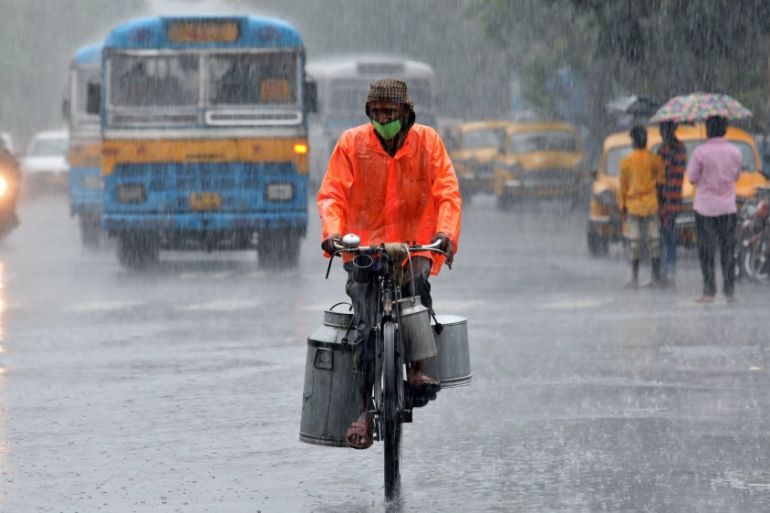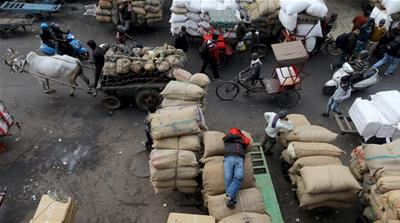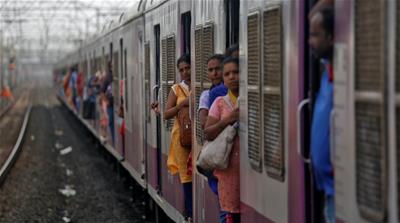India experiences an economic storm as the coronavirus rages
Analysts say India’s economy likely shrank by about 20 percent in the April-June quarter as country went into lockdown.

New Delhi, India: Like many countries, India is experiencing a boom in demand for bicycles, as people shun public transport and gyms for fear of catching the novel coronavirus.
As a result, Inderjit Navyug should be a very happy man right now. But, his bicycle-parts factory in the city of Ludhiana in northern Punjab state has remained shut since late March when India went into lockdown to rein in the spread of the virus.
Keep reading
list of 4 itemsMexico’s teachers seek relief from pandemic-era spike in school robberies
‘A bad chapter’: Tracing the origins of Ecuador’s rise in gang violence
Why is the US economy so resilient?
The nationwide shutdown was lifted in phases starting on June 8, but virus cases have surged past 3.3 million, making India the third-worst affected country globally. Some states, like Punjab, have decided to maintain some restrictions, and Navyug’s 35 workers are afraid to return until the virus has been brought under control, he says.
“My sales have dropped completely,” Navyug told Al Jazeera. His company had a revenue of $140,000 last year, and he is not hopeful of achieving anything near that this year. “I have sent money to the workers. I hope they’ll rejoin next month,” he said.
Navyug’s firm is one of the hundreds of thousands of small Indian manufacturers whose business has been decimated by the virus. His plight is a reflection of the deep economic slump India is likely to face for some time.
India’s economy – the world’s fifth largest – had already been sputtering before the pandemic. But the lockdown, one of the world’s strictest, crippled most economic and commercial activities.
The economy is expected to have shrunk by about 20 percent in the April-June quarter compared with the same period last year, likely setting a record, according to recent polls of economists by the Reuters and Bloomberg news agencies, capturing most of the lockdown period.
For the full financial year to end-March 2021, the Reuters survey predicts gross domestic product (GDP) will shrink by 5.1 percent, the weakest performance since 1979. The government is due to release its GDP data for the April-June quarter on Monday.
Rahul Bajoria, an economist at London-based lender Barclays, has an even more pessimistic outlook. In a research note this month, he said the economy probably shrank by 25.5 percent over the three months, which is worse than his earlier 22.2 percent contraction forecast.
![India GDP forecasts vs reality chart [Bloomberg]](/wp-content/uploads/2020/08/fc21371dd0e349abb9426644c3564c8e_18.jpeg)
“If you shut everything down for six to seven weeks, obviously everything is going to be impacted,” Bajoria told Al Jazeera. “India’s biggest challenge right now is how do you go back to a certain amount of normalcy and how do you grow from there?”
In an attempt to do that, India’s finance minister, Nirmala Sitharaman, in May launched a $265bn fiscal stimulus package, which it said amounted to 10 percent of the country’s GDP. But, economists say the actual amount of money spent is expected to be just 1 percent of total economic output and that it is unlikely to significantly boost consumer demand.
Business unusual
After the government began reopening the economy in phases on June 8, there was a noticeable jump in several sectors. Sales of passenger cars and motorbikes, among other goods, rose, as did electricity demand and commercial activity, including manufacturing. But those metrics have since started to slow down, a sign that, while the number of coronavirus cases continues to increase, the economy will not return to pre-pandemic levels, economists warn.
“Things can’t be business as usual [while] the health crisis persists,” said Bajoria, adding that even if all sectors of the economy, such as travel and tourism, opened up, people have to feel safe enough to want to pursue those activities.
“It’s one thing [for] the government not allowing certain types of economic activity and it’s another to see if people want to partake like they used to. Economic normalcy will only come when the health crisis appears under control.”
While the economy has improved in comparison to where it was at the start of the lockdown, “the pace of the improvement is looking much shallower than what we were anticipating and that concerns us,” said Barclays’s Bajoria.

The other problem is that even as the country has opened up for business, sporadic local lockdowns continue. Because of its federal structure, individual states have a large degree of autonomy over whether they open parts of the economy allowed by New Delhi, or not.
Among the latest such decrees, Punjab imposed a night-time curfew from 7pm to 5am and a weekend lockdown from August 21 in all towns and villages across the state. On the same date, Haryana announced that only essential shops and offices will be allowed to operate on weekends.
Gurpargat S Kahlon, who manufactures auto parts in Ludhiana, mostly for export to the Middle East, Germany and the United States, is also feeling the effects of Punjab’s measures.
He had already been dealing with a drop in orders, a shortage of workers and looming bank repayments, among other issues, during the nationwide lockdown. As a result, his two factories are running at half capacity, he said.
Now, with the 7pm curfew in place, he has to shut shop earlier than normal and expects annual revenue to halve to about $700,000.
“Our industry has been badly hit and now not even half the business is left and it’s getting difficult to pay salaries,” he told Al Jazeera, adding, “There’s no sight on orders down the line and we can’t go abroad to secure new orders and neither can they come here.”
“That’s the worst part right now,” said Madan Sabnavis, chief economist at research firm CARE Ratings, adding that measures such as the ones Punjab are implementing are disrupting supply chains, limiting businesses from operating and increasing costs. “What they’re doing is not serving any purpose,” he told Al Jazeera.
CARE has predicted a 20.2 percent shrinkage in India’s economy for the quarter ending June, citing a steep contraction in industrial activity including mining and quarrying, manufacturing, utility services and construction.
Selling the family silver?
The government is somewhat hamstrung in its ability to provide much more of a fiscal stimulus. The slowdown in activity has resulted in a 41 percent drop in tax collections, amounting to about $25bn for the quarter to end-June compared with the same period last year, according to CARE.
The government’s measures to protect small businesses and rural populations are expected to result in a fiscal deficit – a shortfall between revenue and expenditure – amounting to 7.4 percent of GDP in 2020, according to the International Monetary Fund (IMF).

That is a smaller gap than the IMF’s 9.1 percent average forecast for emerging-market and middle-income countries.
But, India has already seen a cut in its credit rating and outlook by Moody’s in June, and a change in outlook from the Fitch ratings agency. Analysts say the government is wary of increasing spending in case it results in more downgrades, pushing its cost of borrowing funds from international markets higher.
To raise the extra funds, one option could be to sell off some government assets, says Jagannarayan Padmanabhan, director at CRISIL Ltd, a unit of rating agency S&P Global.
In July, state-owned Indian Railways invited bids from private firms to operate some passenger trains, a step towards diluting its long-held monopoly. The government is inviting bids for 109 rail routes (which it calls origin and destination pairs) which will cover the major economic hubs of the country including, Mumbai, Bengaluru, New Delhi, Chennai, Howrah, among others, for an estimated investment of about $4bn.
“No doubt this is an opportunity with a fair amount of interest for the private sector,” said Padmanabhan.
The vast network of Indian railways is tested daily with millions of passengers travelling on it. The private companies wading into this sector are being drawn in by the same incentives that helped India’s budget airlines take off: the aspiration among Indian people for faster, more pleasant travel at an affordable price.
Achieving that balance will be the tricky part for any company getting involved, as Indian consumers are very price-conscious, warns Padmanabhan.
But ultimately, the “need for travel will continue, and if this is successful, the government can open this sector further and the initial set of operators [who bid for the routes] can catch the population in the first mover advantage,” he added.
Padmanabhan has other suggestions to help the government not only find some revenue streams in the short term, but also help it meet an ambitious target of investing $1.4 trillion through the National Infrastructure Pipeline over the next five years to upgrade the country’s ports, airports, railways and mass-transit metro systems. It also aims to provide affordable and clean energy as well as high-quality education and health services, among other investments.
“Where will you get so much money?” he asked.
If, given the current economic uncertainty, companies are unwilling to invest money in new projects, Padmanabhan suggests auctioning to them existing ones so the government can use those funds to create new infrastructure. “Milk the tier-one airports [and highways] and use that to fund regional airports, for instance. It can be one of the pillars of go-to market strategy,” he said.
However, such strategies may not be useful in providing any immediate economic relief, other economists warn.
CARE Ratings’ Sabnavis said: “These things will work over a period of time, and are good in the medium term to earn income but they won’t be of any help to the economy right now.”